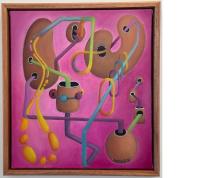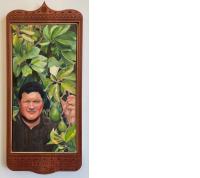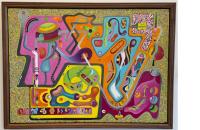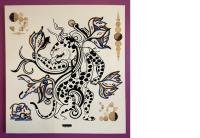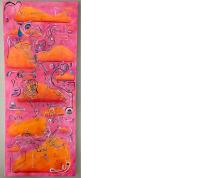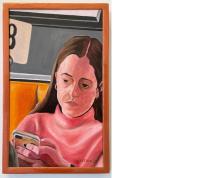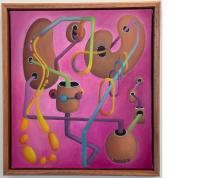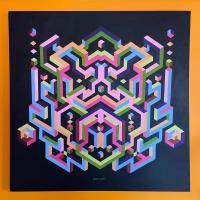Kansas City native Robert Castillo is a multi-instrumentalist, composer, music producer and visual artist. His work is driven by creative experimentation and draws inspiration from his heritage, his music background and abstract art. Robert’s artwork will be on display at the Lenexa City Center branch until April 30, 2023.
What comes first – the medium or the message? Tell me a little about the work that will be on view.
The sequence of projects I work on is guided by what my Spirit is most drawn to creating next. “Of Elsewhere” was a completely improvised piece created in response to having previously completed a very detailed portrait commission. Having to focus on the minutiae of a human portrait prompted an interest in creating completely from the imagination. That being said, most of my work has a detailed story behind the reason for its existence. My Mayan works stem from an interest in exploring my father’s heritage. My geometric abstract pieces come from my love of paintings by Kandinsky. I believe art, and aesthetic in general, evolves when we allow ourselves to experiment across genres/styles and create limitlessly.
What was the most important thing you learned from being a self-taught artist? What’s something inherent in your art that couldn’t be taught?
One of the greatest lessons I’ve learned through teaching myself visual art is that there are no “rights” or “wrongs.” My formal education is as a jazz bassist, and I've composed a vast portfolio of music. I’ve noticed that when composing, I have to actively ignore the voices of my professors telling me how I “should” approach creating. Over time I’ve taught myself to disregard these voices, but it took intentional effort. Being self-taught as a visual artist, I don’t have these voices “shoulding” all over me and as a result I feel more comfortable expressing in whatever way feels necessary.
Something inherent in art that cannot be taught are the physical sensations of painting. There are very important nuances when painting related to how wet your brush is, how much paint is on the brush, how much paint is on the canvas where you’re going to paint, etc…these cannot be taught, they can only be learned through feel.
You are also a musician – does music influence your visual art?
Oh yes, heavily. As a jazz musician, improvisation is one of our most implemented techniques. This requires a very deep knowledge of music theory and harmony, combined with many hours of practice to deeply internalize this information. Because playing jazz requires such an intricate working knowledge of music theory, I do subscribe to the idea that jazz is the most complex version of music performance. This interest in learning the most complex version of an art from is what inspired me to learn to paint with oils. Oil paints have been used for centuries by all the great masters and most paintings in museums are created with oils. Out of all painting mediums, oil paints allow for the most detail and luminescence. Having had the experience of learning a complex form of music eased the way for me to learn a complex version of painting.

What is your dream project?
Through the centuries, artists have created their own versions of “The Temptation of St Anthony.” Bosch, Ernst, Cezanne, and Dali are among those who have painted their take on the desert pilgrimage documented by St Anthony of Egypt. Not long after learning about this story and its documentation over time, I bought the materials to create an 80 x 100” version myself. I also purchased St. Anthony’s book documenting his desert pilgrimage, to have as much context as possible when creating the piece. My dream is to have access to a room large enough, for several months, to support me working on a painting this large.
What is your most important artist tool? Is there something you can’t live without in your studio?
It’s difficult to narrow this down to one. My mahl stick is certainly one of my most important tools. A mahl stick allows an artist to rest their hand on the stick itself, avoiding placing their hand in wet paint. The version I have is called a mahl fork created by a dude in Australia, and I learned about it when watching oil painting videos on YouTube by Andrew Tischler. My painting stool is also an extremely important tool. Because I’ll sit working on a painting for 70+ hours, I purchased an ergonomic stool built for drummers to support proper posture over extended periods of time. My glass palette is also super helpful. When I’m done with a painting, I just scrape the old paint off with a razor and have a totally clean and fresh surface to work with again.
Please list 5-10 books, movies and/or music that currently inspire you?
books
The Foundation Series by Isaac Asimov
The Gods Themselves by Isaac Asimov
You Are Not Broken by KJ Casperson
Guns, Germs, and Steel by Jared Diamond
music
Phantasmagoria by Mr. Bill
Un Canto por México Vol.1 by Natalia Lafourcade
The Melody of Rhythm by Béla Fleck, Zakir Hussain & Edgar Meyer

